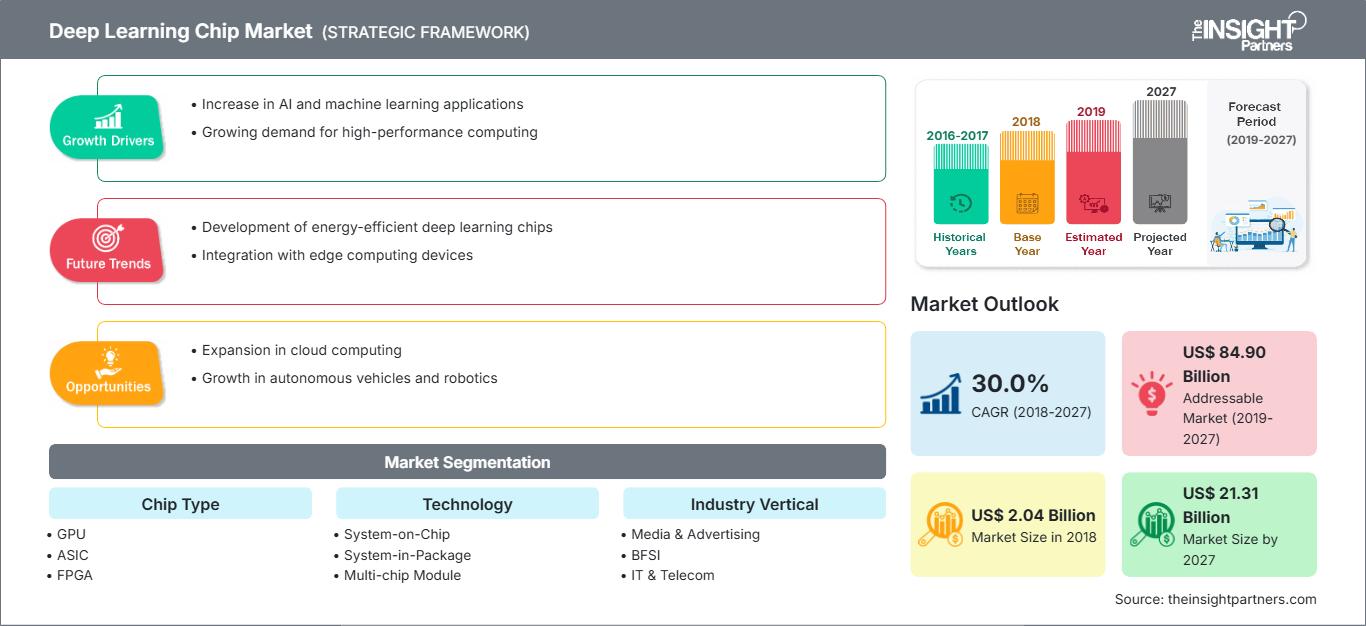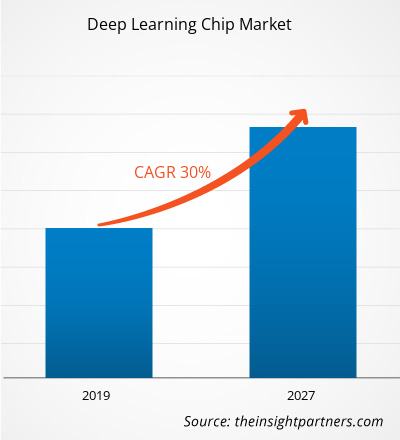Il mercato globale dei chip per il deep learning ha raggiunto i 2,04 miliardi di dollari nel 2018 e si prevede che crescerà a un CAGR del 30,0% nel periodo di previsione 2019-2027, fino a raggiungere i 21,31 miliardi di dollari entro il 2027.
Il Nord America è leader nel mercato globale dei chip per il deep learning e si prevede che sarà il maggiore contributore di fatturato durante il periodo di previsione. Lo sviluppo di chip per il deep learning è sostenuto da investimenti su larga scala da parte dei giganti della tecnologia per sviluppare modelli a partire da un'enorme quantità di dati generati. L'ascesa del calcolo quantistico e l'implementazione di chip per il deep learning nella robotica stanno guidando la crescita del mercato dei chip per il deep learning nei paesi nordamericani.
Approfondimenti di mercato: l'importanza del calcolo quantistico contribuisce alla crescita del mercato dei chip per il deep learning
Il calcolo quantistico impiega pochi secondi per completare un calcolo che altrimenti richiederebbe più tempo. I computer quantistici rappresentano una trasformazione innovativa dell'intelligenza artificiale, dell'apprendimento automatico e dei big data. Pertanto, si prevede che l'importanza del calcolo quantistico guiderà la crescita del mercato dei chip per il deep learning. Inoltre, il calcolo quantistico è vantaggioso per diversi fattori, tra cui l'ottimizzazione del portafoglio, il rilevamento delle frodi e la gestione del rischio, nonché per le aree in cui è richiesto un feedback immediato sui dati. Pertanto, è più facile per un singolo processore eseguire calcoli complessi in pochi secondi. Inoltre, grazie alla scala e alle dimensioni di Internet, il deep learning aiuta a gestire grandi set di dati a costi molto bassi. Pertanto, si prevede che questi fattori stimoleranno la crescita del mercato globale dei chip per il deep learning.
Personalizza questo rapporto in base alle tue esigenze
Potrai personalizzare gratuitamente qualsiasi rapporto, comprese parti di questo rapporto, o analisi a livello di paese, pacchetto dati Excel, oltre a usufruire di grandi offerte e sconti per start-up e università
Mercato dei chip per l'apprendimento profondo: Approfondimenti strategici

-
Ottieni le principali tendenze chiave del mercato di questo rapporto.Questo campione GRATUITO includerà l'analisi dei dati, che vanno dalle tendenze di mercato alle stime e alle previsioni.
La natura del business sta diventando molto competitiva e, per competere in modo efficiente, le aziende oggigiorno si affidano a informazioni utili e analisi aziendali. Tradizionalmente, gli strumenti di analisi aziendale venivano utilizzati per proiettare le vendite sulla base di dati relativi a eventi risalenti a una settimana o un mese prima. Con l'avvento della tecnologia di intelligenza artificiale, che apprende in tempo reale e fornisce raccomandazioni basate su modelli, le aziende hanno un'enorme opportunità di applicare il deep learning a vari processi per comprendere meglio l'ambiente aziendale e i clienti.
Considerando questi fattori, l'intelligenza artificiale consente alle aziende di migliorare l'efficienza operativa, ridurre i costi operativi, migliorare la qualità del servizio e l'esperienza del cliente.
Informazioni sul tipo di chip
Le unità di elaborazione grafica (GPU) hanno detenuto la quota di mercato principale dei chip per deep learning nel 2018, mentre si prevede che i circuiti integrati specifici per applicazione (ASIC) saranno il segmento in più rapida crescita durante il periodo di previsione. A causa del fatto che gli ASIC sono molto specifici e meno flessibili, rappresentano una delle opzioni hardware più performanti disponibili per le applicazioni di intelligenza artificiale.
Approfondimenti tecnologici
I chipset per deep learning includono sistemi su chip, sistemi in package, moduli multi-chip e altri ancora. Il segmento dei sistemi su chip ha detenuto la quota di mercato maggiore dei chip per deep learning nel 2018, poiché contribuisce a ridurre gli sprechi energetici, lo spazio occupato dai sistemi di grandi dimensioni e i costi.
Approfondimenti verticali di settore
Il mercato globale dei chip per deep learning è suddiviso in BFSI, Retail, IT e telecomunicazioni, Automotive e trasporti, Sanità, Media e intrattenimento e altri. Il BFSI ha detenuto la quota di mercato maggiore nel mercato dei chip per deep learning, mentre si prevede che il settore sanitario sarà il segmento in più rapida crescita. Fattori quali la riduzione dei costi operativi, l'adattamento a conformità e normative in continua evoluzione, la focalizzazione sul core business e l'integrazione dell'automazione nei processi aziendali sono altri fattori importanti che stanno alimentando la crescita del segmento BFSI nel mercato dei chip per deep learning.
Gli operatori presenti nel mercato dei chip per deep learning si concentrano principalmente sul miglioramento dei prodotti implementando tecnologie avanzate. La stipula di partnership, contratti, joint venture, finanziamenti e l'inaugurazione di nuove sedi in tutto il mondo consentono all'azienda di mantenere il proprio marchio a livello globale. Di seguito sono elencati alcuni degli sviluppi recenti;
2019: NVIDIA ha stretto una partnership con Hackster.io per lanciare l'AI at the Edge Challenge, una competizione in cui gli sviluppatori utilizzano il kit per sviluppatori NVIDIA Jetson Nano per realizzare progetti creativi e unici e avere la possibilità di vincere premi fino a 100.000 dollari.
2019: Intel ha annunciato i suoi piani di ampliamento dello stabilimento in Oregon per produrre un chip a 7 nm. Il nuovo stabilimento Intel rappresenterà la terza fase di D1X, un'enorme fabbrica avviata da Intel nel 2010. Ciascuna delle prime due fasi occupava una superficie di 1,1 milioni di piedi quadrati, creando una struttura complessiva equivalente a 15 magazzini Costco. La terza fase aumenterà apparentemente lo spazio produttivo di D1X di circa il 50%. Inoltre, Intel afferma che l'espansione dello stabilimento le consentirà di rispondere con una rapidità del 60% alla carenza di chip.
2019: Huawei ha lanciato HiSecEngine USG12000, il primo AIFW di livello T del settore. HiSecEngine USG12000 è dotato di chip Ascend AI, che offrono capacità di rilevamento intelligente e protezione intelligente dei confini per le reti aziendali.
Approfondimenti regionali sul mercato dei chip per l'apprendimento profondo
Le tendenze e i fattori regionali che influenzano il mercato dei chip per il Deep Learning durante il periodo di previsione sono stati ampiamente spiegati dagli analisti di The Insight Partners. Questa sezione illustra anche i segmenti e la geografia del mercato dei chip per il Deep Learning in Nord America, Europa, Asia-Pacifico, Medio Oriente e Africa, America Meridionale e Centrale.
Ambito del rapporto sul mercato dei chip per l'apprendimento profondo
| Attributo del rapporto | Dettagli |
|---|---|
| Dimensioni del mercato in 2018 | US$ 2.04 Billion |
| Dimensioni del mercato per 2027 | US$ 21.31 Billion |
| CAGR globale (2018 - 2027) | 30.0% |
| Dati storici | 2016-2017 |
| Periodo di previsione | 2019-2027 |
| Segmenti coperti |
By Tipo di chip
|
| Regioni e paesi coperti |
Nord America
|
| Leader di mercato e profili aziendali chiave |
|
Densità dei player del mercato dei chip di apprendimento profondo: comprendere il suo impatto sulle dinamiche aziendali
Il mercato dei chip per il deep learning è in rapida crescita, trainato dalla crescente domanda degli utenti finali, dovuta a fattori quali l'evoluzione delle preferenze dei consumatori, i progressi tecnologici e una maggiore consapevolezza dei vantaggi del prodotto. Con l'aumento della domanda, le aziende stanno ampliando la propria offerta, innovando per soddisfare le esigenze dei consumatori e sfruttando le tendenze emergenti, alimentando ulteriormente la crescita del mercato.

- Ottieni il Mercato dei chip per l'apprendimento profondo Panoramica dei principali attori chiave
- GPU
- ASIC
- FPGA
- CPU
- Altri
Per tecnologia
- System-on-Chip
- System-in-Package
- Modulo multi-chip
- Altri
Per settore verticale
- Media e pubblicità
- BFSI, IT e telecomunicazioni
- Vendita al dettaglio
- Sanità
- Automotive e Trasporti
- Altri
Per area geografica
-
Nord America
- Stati Uniti
- Canada
- Messico
-
Europa
- Francia
- Germania
- Regno Unito
- Russia
- Italia
- Resto d'Europa
-
Asia Pacifico (APAC)
- Australia
- Cina
- India
- Giappone
- Corea del Sud
- Resto dell'APAC
-
Medio Oriente e Africa (MEA)
- Arabia Saudita
- Sudafrica
- Emirati Arabi Uniti
- Resto del MEA
-
Sud America (SAM)
- Brasile
- Argentina
- Resto del SAM
Profili aziendali
- Advanced Micro Devices, Inc.
- Alphabet Inc. (Google)
- Amazon.com, Inc.
- Baidu, Inc.
- Huawei Technologies Co., Ltd
- Intel Corporation
- NVIDIA Corporation
- Qualcomm Incorporated
- Samsung Electronics Co., Ltd.
- Xilinx, Inc.
- Analisi storica (2 anni), anno base, previsione (7 anni) con CAGR
- Analisi PEST e SWOT
- Valore/volume delle dimensioni del mercato - Globale, Regionale, Nazionale
- Industria e panorama competitivo
- Set di dati Excel
Report recenti
Testimonianze
Motivo dell'acquisto
- Processo decisionale informato
- Comprensione delle dinamiche di mercato
- Analisi competitiva
- Analisi dei clienti
- Previsioni di mercato
- Mitigazione del rischio
- Pianificazione strategica
- Giustificazione degli investimenti
- Identificazione dei mercati emergenti
- Miglioramento delle strategie di marketing
- Aumento dell'efficienza operativa
- Allineamento alle tendenze normative






















 Ottieni un campione gratuito per - Mercato dei chip per l'apprendimento profondo
Ottieni un campione gratuito per - Mercato dei chip per l'apprendimento profondo